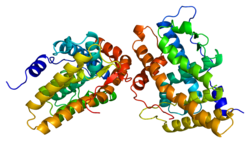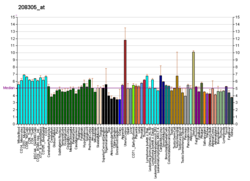아로마타아제
Aromatase| CYP19A1 | |||||||||||||||||||||||||
|---|---|---|---|---|---|---|---|---|---|---|---|---|---|---|---|---|---|---|---|---|---|---|---|---|---|
 | |||||||||||||||||||||||||
| |||||||||||||||||||||||||
| 식별자 | |||||||||||||||||||||||||
| 별칭 | CYP19A1, ARO1, CPV1, CYAR, CYP19, CYPXIX, P-450AROM, Cytochrome P450 계열 A 회원 1 | ||||||||||||||||||||||||
| 외부 ID | OMIM: 107910 MGI: 88587 호몰로진: 30955 GeneCard: CYP19A1 | ||||||||||||||||||||||||
| |||||||||||||||||||||||||
| |||||||||||||||||||||||||
| |||||||||||||||||||||||||
| |||||||||||||||||||||||||
| 직교체 | |||||||||||||||||||||||||
| 종 | 인간 | 마우스 | |||||||||||||||||||||||
| 엔트레스 | |||||||||||||||||||||||||
| 앙상블 | |||||||||||||||||||||||||
| 유니프로트 | |||||||||||||||||||||||||
| RefSeq(mRNA) |
| ||||||||||||||||||||||||
| RefSeq(단백질) |
| ||||||||||||||||||||||||
| 위치(UCSC) | Cr 15: 51.21 – 51.34Mb | Cr 9: 54.17 – 54.27Mb | |||||||||||||||||||||||
| PubMed 검색 | [3] | [4] | |||||||||||||||||||||||
| 위키다타 | |||||||||||||||||||||||||
| |||||||||||||||||||||||||
에스트로겐 합성효소 또는 에스트로겐 싱타아제라고도 불리는 아로마타아제는 에스트로겐의 생합성의 핵심 단계를 담당하는 효소다. 스테로이드제네시스(Steroidogenesis)와 관련된 많은 반응을 촉진하는 단독성 물질인 시토크롬 P450 슈퍼 패밀리(EC 1.14.14.1)의 멤버인 CYP19A1이다. 특히 아로마타제는 안드로겐을 에스트로겐으로 아로마화시키는 역할을 한다. 아로마타아제 효소는 생식선(그란울로사 세포), 뇌, 지방 조직, 태반, 혈관, 피부, 뼈 등 많은 조직에서 발견될 수 있으며 자궁내막증, 자궁 섬유종, 유방암, 자궁내막암 조직에서도 발견될 수 있다.[citation needed] 그것은 성적 발달에 중요한 요소다.
함수
아로마타아제는 호르몬, 사이토카인, 기타 요인에 의해 차례로 조절되는 조직 특유의 촉진제에 의해 조절되는 내소성 망막에 국소화된다. 에스트로겐 생합성의 마지막 단계를 안드로겐(특히 안드로겐디온을 에스트로겐으로, 테스토스테론을 에스트로겐으로 변환한다)에서 촉매로 한다. 이러한 단계에는 안드로겐 19-메틸 그룹의 3회 연속 히드록실화가 포함되며, 이후 A-링의 포메이트와 아로마화로서 메틸 그룹을 동시에 제거한다.
- 안드로스테디온 + 3O2 + 3NADPH + 3H+ 에스트론 + 포마테 + 4HO2 + 3NADP
- 테스토스테론 + 3O2 + 3NADPH + 3H+ 17β-estradiol + Formate + 4HO2 + 3NADP
표현
아로마타아제는 생식선, 태반, 뇌, 지방 조직, 뼈, 그리고 다른 조직에서 발현된다.[citation needed] 그것은 성인 인간의 간에서는 거의 감지할 수 없다.[6]
게노믹스
그 유전자는 두 가지의 대본 변형을 표현한다.[7] 인간의 경우 15q21.1번 염색체에 위치한 CYP19 유전자는 아로마타아제를 암호화한다.[8] 이 유전자는 9개의 코딩 엑손과 조직별 발현을 조절하는 다수의 대체 비코딩 첫 번째 엑손들을 가지고 있다.[9]
CYP19는 초기 발현 화음인 두팔로코르드산 암피오수스(플로리다 랜슬렛, Branchostoma florae)에 존재하지만, 초기에 갈라진 튜니케이트 시오나 장내염에는 존재하지 않는다. 따라서 아로마타아제 유전자는 화음 진화 초기에 진화했으며 비초산 무척추동물(예: 곤충, 연체동물, 에치노데름, 해면체, 산호)에는 존재하지 않는 것으로 보인다. 그러나, 에스트로겐은 다른 알려지지 않은 경로를 통해 이러한 유기체들 중 일부에서 합성될 수 있다.
활동
아로마타아제 활성은 뮐러 호르몬인 프로락틴에 의해 감소한다. 아로마타아제 활성은 유방조직, 자궁내막암, 자궁섬유종 옆에 있는 특정 에스트로겐 의존성 국소조직에서 강화되는 것으로 보인다.
성 결정의 역할
아로마타아제는 일반적으로 난소의 분화 과정에서 많이 나타난다.[10][11] 그것은 또한 환경적 영향, 특히 온도에 영향을 받기 쉽다. 온도에 의존하는 성 결정체를 가진 종에서 아로마타아제는 암컷 자손을 낳는 온도에서 더 많은 양으로 표현된다.[10] 데이터가 아로마타아제 양을 조절한다고 제안함에도 불구하고, 다른 연구들은 아로마타아제가 온도의 영향을 압도할 수 있다는 것을 보여주었다: 만약 남성이 생산되는 온도에서 더 많은 아로마타아제에 노출된다면, 유기체는 암컷이 될 것이고 반대로 여성이 생산되는 온도에서 아로마타아제에 덜 노출된다면 유기체는 암컷이 될 것이다.남성 발육 불량(성역전 참조).[10] 유전적 성별 결정을 통해 발달하는 유기체에서는 온도가 아로마타아제 발현과 기능에 영향을 주지 않으며, 이는 아로마타아제가 TSD[10] 기간 동안 온도에 대한 표적 분자임을 시사한다(이 주장에 대한 도전은 온도 의존적 성 결정 참조). 온도차가 다른 아로마타아제 단백질인지, 아로마타아제 유전자가 겪는 전사량이 온도에 민감한 것인지 종마다 다르지만, 어느 경우든 다른 온도에서 미분발전이 관찰된다.[12]
신경치료의 역할
뇌의 아로마타아제는 보통 뉴런으로만 표현된다. 그러나 쥐와 얼룩말 지느러미의 침투성 뇌손상에 이어 아스트로사이테로 표현되는 것으로 나타났다.[13] 그것은 또한 얼룩말 지느러미에서 뇌손상에 따른 사멸을 감소시키는 것으로 나타났다.[14] 이는 에스트라디올을 포함한 에스트로겐의 신경보호 작용 때문이라고 생각된다. 연구 결과 두 개의 친염성 사이토카인 인터루킨-1β(IL-1β)와 인터루킨-6(IL-6)이 제브라 핀치의 침투성 뇌손상에 따른 아로마타아제 발현 유도에 책임이 있는 것으로 밝혀졌다.[15]
장애
아로마타아제 과다증후군
많은 조사관들이 과도한 아로마타제 활동의 다소 희귀한 증후군에 대해 보고했다. 남자아이에서는 자이에코마스티아를, 여자아이에서는 조숙한 사춘기와 지간토마스티아를 일으킨다. 남녀 모두 초기 후두막 폐쇄는 단신으로 이어진다. 이 증상은 아로마타아제를 암호화하는 CYP19A1 유전자의 돌연변이에 기인한다.[16] 그것은 자가복음 지배적인 방식으로 유전된다.[17] 파라오 아케나텐과 그의 가족의 다른 구성원들이 이 질환을 앓았을 수도 있다는 주장이 제기되었지만,[18] 최근의 더 많은 유전자 검사들은 그렇지 않다는 것을 시사한다.[19] 그것은 가족성조숙 사춘기의 원인 중 하나로, 1937년에 처음 묘사된 질환이다.[20]
아로마타아제 결핍증후군
이 증후군은 유전자 CYP19의 돌연변이에 기인하며 자가 열성적으로 유전된다. 임신 중 안드로겐의 축적은 출생 시에 암컷의 처녀성을 유발할 수 있다. (수염은 영향을 받지 않는다.) 암컷은 일차적 아메노레아를 갖게 될 것이다. 에스트로겐의 부족이 후두막을 닫게 하지 않기 때문에 남녀노소 모두 키가 클 것이다.
아로마타아제 억제
아로마타아제의 억제는 저자극성(에스트로겐 수치가 낮음)을 유발할 수 있다. 다음 천연물은 아로마타아제 억제 효과가 있는 것으로 밝혀졌다.
특정(흰색 버튼 품종: Agaricus bisporus) 버섯 추출물이 체외 아로마타제를 억제하는 것으로 나타났다.[31]
제약 방향제 억제제
폐경 후 여성의 에스트로겐 생성을 중단시키는 아로마타아제 억제제는 병변이 에스트로겐 수용체 양성인 것으로 밝혀진 유방암 환자의 관리에 유용하게 쓰이게 됐다.[32] 현재 임상적으로 사용되고 있는 억제제로는 아나스트로졸, 엑세스타인, 레트로졸 등이 있다. 아로마타아제 억제제는 남성들에게 테스토스테론 대체 요법으로 처방되기 시작하고 있다. 일단 그들의 시스템에 테스토스테론이 투여되면 에스트로겐 수치가 치솟는 것을 막기 위한 방법이기 때문이다.
참고 항목
참조
- ^ a b c GRCh38: 앙상블 릴리스 89: ENSG00000137869 - 앙상블, 2017년 5월
- ^ a b c GRCm38: 앙상블 릴리스 89: ENSMUSG000032274 - 앙상블, 2017년 5월
- ^ "Human PubMed Reference:". National Center for Biotechnology Information, U.S. National Library of Medicine.
- ^ "Mouse PubMed Reference:". National Center for Biotechnology Information, U.S. National Library of Medicine.
- ^ Vaz AD (2003). "Chapter 1: Cytochrome activation by cytochromes P450: a role for multiple oxidants in the oxidation of substrates". In Fisher M, Lee JK, Obach RE (eds.). Drug metabolizing enzymes: cytochrome P450 and other enzymes in drug discovery and development. Lausanne, Switzerland: FontisMedia SA. ISBN 978-0-8247-4293-5.
- ^ Hata S, Miki Y, Saito R, Ishida K, Watanabe M, Sasano H (June 2013). "Aromatase in human liver and its diseases". Cancer Med. 2 (3): 305–15. doi:10.1002/cam4.85. PMC 3699842. PMID 23930207.
- ^ "Entrez Gene: CYP19A1 cytochrome P450, family 19, subfamily A, polypeptide 1".
- ^ Toda K, Shizuta Y (April 1993). "Molecular cloning of a cDNA showing alternative splicing of the 5'-untranslated sequence of mRNA for human aromatase P-450". European Journal of Biochemistry. 213 (1): 383–9. doi:10.1111/j.1432-1033.1993.tb17772.x. PMID 8477708.
- ^ Czajka-Oraniec I, Simpson ER (2010). "Aromatase research and its clinical significance". Endokrynologia Polska. 61 (1): 126–34. PMID 20205115.
- ^ a b c d Duffy TA, Picha ME, Won ET, Borski RJ, McElroy AE, Conover DO (August 2010). "Ontogenesis of gonadal aromatase gene expression in atlantic silverside (Menidia menidia) populations with genetic and temperature-dependent sex determination". Journal of Experimental Zoology Part A. 313 (7): 421–31. doi:10.1002/jez.612. PMID 20623799.
- ^ Kohno S, Katsu Y, Urushitani H, Ohta Y, Iguchi T, Guillette LJ (2010). "Potential contributions of heat shock proteins to temperature-dependent sex determination in the American alligator". Sexual Development. 4 (1–2): 73–87. doi:10.1159/000260374. PMC 2855287. PMID 19940440.
- ^ Gilbert SF (2010). Developmental biology. Sunderland, Mass: Sinauer Associates. ISBN 978-0-87893-384-6.
- ^ Garcia-Segura LM, Wozniak A, Azcoitia I, Rodriguez JR, Hutchison RE, Hutchison JB (March 1999). "Aromatase expression by astrocytes after brain injury: implications for local estrogen formation in brain repair". Neuroscience. 89 (2): 567–78. doi:10.1016/s0306-4522(98)00340-6. PMID 10077336. S2CID 24689059.
- ^ Saldanha CJ, Rohmann KN, Coomaralingam L, Wynne RD (August 2005). "Estrogen provision by reactive glia decreases apoptosis in the zebra finch (Taeniopygia guttata)". Journal of Neurobiology. 64 (2): 192–201. doi:10.1002/neu.20147. PMID 15818556.
- ^ Duncan KA, Saldanha CJ (July 2011). "Neuroinflammation induces glial aromatase expression in the uninjured songbird brain". Journal of Neuroinflammation. 8 (81): 81. doi:10.1186/1742-2094-8-81. PMC 3158750. PMID 21767382.
- ^ Fukami M, Shozu M, Ogata T (2012). "Molecular bases and phenotypic determinants of aromatase excess syndrome". International Journal of Endocrinology. 2012: 584807. doi:10.1155/2012/584807. PMC 3272822. PMID 22319526.
- ^ Fukami M, Shozu M, Soneda S, Kato F, Inagaki A, Takagi H, Hanaki K, Kanzaki S, Ohyama K, Sano T, Nishigaki T, Yokoya S, Binder G, Horikawa R, Ogata T (June 2011). "Aromatase excess syndrome: identification of cryptic duplications and deletions leading to gain of function of CYP19A1 and assessment of phenotypic determinants". The Journal of Clinical Endocrinology and Metabolism. 96 (6): E1035-43. doi:10.1210/jc.2011-0145. PMID 21470988.
- ^ Braverman IM, Redford DB, Mackowiak PA (April 2009). "Akhenaten and the strange physiques of Egypt's 18th dynasty". Annals of Internal Medicine. 150 (8): 556–60. doi:10.7326/0003-4819-150-8-200904210-00010. PMID 19380856. S2CID 24766974.
- ^ Seshadri KG (May 2012). "The breasts of Tutankhamun". Indian Journal of Endocrinology and Metabolism. 16 (3): 429–30. doi:10.4103/2230-8210.95696. PMC 3354854. PMID 22629513.
- ^ Ziora K, Oświecimska J, Geisler G, Broll-Waśka K, Szalecki M, Dyduch A (2006). "[Familial precocious puberty -- a variant of norm or pathology?]". Endokrynologia, Diabetologia I Choroby Przemiany Materii Wieku Rozwojowego (in Polish). 12 (1): 53–8. PMID 16704862.
- ^ a b c d Balunas MJ, Su B, Brueggemeier RW, Kinghorn AD (August 2008). "Natural products as aromatase inhibitors". Anti-Cancer Agents in Medicinal Chemistry. 8 (6): 646–82. doi:10.2174/1871520610808060646. PMC 3074486. PMID 18690828.
- ^ Satoh K, Sakamoto Y, Ogata A, Nagai F, Mikuriya H, Numazawa M, Yamada K, Aoki N (July 2002). "Inhibition of aromatase activity by green tea extract catechins and their endocrinological effects of oral administration in rats". Food and Chemical Toxicology. 40 (7): 925–33. doi:10.1016/S0278-6915(02)00066-2. PMID 12065214.
- ^ Kapiszewska M, Miskiewicz M, Ellison PT, Thune I, Jasienska G (May 2006). "High tea consumption diminishes salivary 17beta-estradiol concentration in Polish women". The British Journal of Nutrition. 95 (5): 989–95. doi:10.1079/BJN20061755. PMID 16611391.
- ^ Le Bail JC, Pouget C, Fagnere C, Basly JP, Chulia AJ, Habrioux G (January 2001). "Chalcones are potent inhibitors of aromatase and 17beta-hydroxysteroid dehydrogenase activities". Life Sciences. 68 (7): 751–61. doi:10.1016/S0024-3205(00)00974-7. PMID 11205867.
- ^ Ye L, Chan FL, Chen S, Leung LK (October 2012). "The citrus flavonone hesperetin inhibits growth of aromatase-expressing MCF-7 tumor in ovariectomized athymic mice". The Journal of Nutritional Biochemistry. 23 (10): 1230–7. doi:10.1016/j.jnutbio.2011.07.003. PMID 22209285.
- ^ Doering IL, Richter E (April 2009). "Inhibition of human aromatase by myosmine". Drug Metabolism Letters. 3 (2): 83–6. doi:10.2174/187231209788654045. PMID 19601869.
- ^ Biegon A, Kim SW, Logan J, Hooker JM, Muench L, Fowler JS (April 2010). "Nicotine blocks brain estrogen synthase (aromatase): in vivo positron emission tomography studies in female baboons". Biological Psychiatry. 67 (8): 774–7. doi:10.1016/j.biopsych.2010.01.004. PMC 2904480. PMID 20188349.
- ^ Wang Y, Lee KW, Chan FL, Chen S, Leung LK (July 2006). "The red wine polyphenol resveratrol displays bilevel inhibition on aromatase in breast cancer cells". Toxicological Sciences. 92 (1): 71–7. doi:10.1093/toxsci/kfj190. PMID 16611627.
- ^ Siler U, Barella L, Spitzer V, Schnorr J, Lein M, Goralczyk R, Wertz K (June 2004). "Lycopene and vitamin E interfere with autocrine/paracrine loops in the Dunning prostate cancer model". FASEB Journal. 18 (9): 1019–21. doi:10.1096/fj.03-1116fje. PMID 15084515. S2CID 26424745.
- ^ Om AS, Chung KW (April 1996). "Dietary zinc deficiency alters 5 alpha-reduction and aromatization of testosterone and androgen and estrogen receptors in rat liver". The Journal of Nutrition. 126 (4): 842–8. doi:10.1093/jn/126.4.842. PMID 8613886.
- ^ Chen S, Oh SR, Phung S, Hur G, Ye JJ, Kwok SL, Shrode GE, Belury M, Adams LS, Williams D (December 2006). "Anti-aromatase activity of phytochemicals in white button mushrooms (Agaricus bisporus)". Cancer Research. 66 (24): 12026–34. doi:10.1158/0008-5472.CAN-06-2206. PMID 17178902.
- ^ "Aromatase Inhibitors". Breastcancer.org.
추가 읽기
- Attar E, Bulun SE (May 2006). "Aromatase inhibitors: the next generation of therapeutics for endometriosis?". Fertility and Sterility. 85 (5): 1307–18. doi:10.1016/j.fertnstert.2005.09.064. PMID 16647373.
- Chen S (August 1998). "Aromatase and breast cancer". Frontiers in Bioscience. 3 (4): d922–33. doi:10.2741/A333. PMID 9696881.
- Strobel HW, Thompson CM, Antonovic L (June 2001). "Cytochromes P450 in brain: function and significance". Current Drug Metabolism. 2 (2): 199–214. doi:10.2174/1389200013338577. PMID 11469726.
- Simpson ER, Clyne C, Rubin G, Boon WC, Robertson K, Britt K, Speed C, Jones M (2002). "Aromatase--a brief overview". Annual Review of Physiology. 64: 93–127. doi:10.1146/annurev.physiol.64.081601.142703. PMID 11826265.
- Bulun SE, Yang S, Fang Z, Gurates B, Tamura M, Zhou J, Sebastian S (December 2001). "Role of aromatase in endometrial disease". The Journal of Steroid Biochemistry and Molecular Biology. 79 (1–5): 19–25. doi:10.1016/S0960-0760(01)00134-0. PMID 11850203. S2CID 7642211.
- Balthazart J, Baillien M, Ball GF (December 2001). "Phosphorylation processes mediate rapid changes of brain aromatase activity". The Journal of Steroid Biochemistry and Molecular Biology. 79 (1–5): 261–77. doi:10.1016/S0960-0760(01)00143-1. PMID 11850233. S2CID 34269540.
- Richards JA, Petrel TA, Brueggemeier RW (February 2002). "Signaling pathways regulating aromatase and cyclooxygenases in normal and malignant breast cells". The Journal of Steroid Biochemistry and Molecular Biology. 80 (2): 203–12. doi:10.1016/S0960-0760(01)00187-X. PMID 11897504. S2CID 12728545.
- Balthazart J, Baillien M, Ball GF (May 2002). "Interactions between aromatase (estrogen synthase) and dopamine in the control of male sexual behavior in quail". Comparative Biochemistry and Physiology. Part B, Biochemistry & Molecular Biology. 132 (1): 37–55. doi:10.1016/S1096-4959(01)00531-0. PMID 11997208.
- Meinhardt U, Mullis PE (2002). "The aromatase cytochrome P-450 and its clinical impact". Hormone Research. 57 (5–6): 145–52. doi:10.1159/000058374. PMID 12053085. S2CID 24115725.
- Carreau S, Bourguiba S, Lambard S, Galeraud-Denis I, Genissel C, Levallet J (July 2002). "Reproductive system: aromatase and estrogens". Molecular and Cellular Endocrinology. 193 (1–2): 137–43. doi:10.1016/S0303-7207(02)00107-7. PMID 12161013. S2CID 34446206.
- Meinhardt U, Mullis PE (August 2002). "The essential role of the aromatase/p450arom". Seminars in Reproductive Medicine. 20 (3): 277–84. doi:10.1055/s-2002-35374. PMID 12428207.
- Carreau S, Bourguiba S, Lambard S, Galeraud-Denis I (2003). "[Testicular aromatase]". Journal de la Société de Biologie. 196 (3): 241–4. doi:10.1051/jbio/2002196030241. PMID 12462076.
- Carani C, Fabbi M, Zirilli L, Sgarbi I (2003). "[Estrogen resistance and aromatase deficiency in humans]". Journal de la Société de Biologie. 196 (3): 245–8. doi:10.1051/jbio/2002196030245. PMID 12462077.
- Kragie L (August 2002). "Aromatase in primate pregnancy: a review". Endocrine Research. 28 (3): 121–8. doi:10.1081/ERC-120015041. PMID 12489562. S2CID 8509882.
- Simpson ER (July 2000). "Biology of aromatase in the mammary gland". Journal of Mammary Gland Biology and Neoplasia. 5 (3): 251–8. doi:10.1023/A:1009590626450. PMID 14973387. S2CID 13296474.
- Bulun SE, Takayama K, Suzuki T, Sasano H, Yilmaz B, Sebastian S (February 2004). "Organization of the human aromatase p450 (CYP19) gene". Seminars in Reproductive Medicine. 22 (1): 5–9. doi:10.1055/s-2004-823022. PMID 15083376.
- Simpson ER (February 2004). "Aromatase: biologic relevance of tissue-specific expression". Seminars in Reproductive Medicine. 22 (1): 11–23. doi:10.1055/s-2004-823023. PMID 15083377.
- Bulun SE, Fang Z, Imir G, Gurates B, Tamura M, Yilmaz B, Langoi D, Amin S, Yang S, Deb S (February 2004). "Aromatase and endometriosis". Seminars in Reproductive Medicine. 22 (1): 45–50. doi:10.1055/s-2004-823026. PMID 15083380.
- Shozu M, Murakami K, Inoue M (February 2004). "Aromatase and leiomyoma of the uterus". Seminars in Reproductive Medicine. 22 (1): 51–60. doi:10.1055/s-2004-823027. PMID 15083381.
- Chen S, Ye J, Kijima I, Kinoshita Y, Zhou D (May 2005). "Positive and negative transcriptional regulation of aromatase expression in human breast cancer tissue". The Journal of Steroid Biochemistry and Molecular Biology. 95 (1–5): 17–23. doi:10.1016/j.jsbmb.2005.04.002. PMID 15955695. S2CID 22138523.
- Lambard S, Silandre D, Delalande C, Denis-Galeraud I, Bourguiba S, Carreau S (May 2005). "Aromatase in testis: expression and role in male reproduction". The Journal of Steroid Biochemistry and Molecular Biology. 95 (1–5): 63–9. doi:10.1016/j.jsbmb.2005.04.020. PMID 16019206. S2CID 40087589.
- Bulun SE, Imir G, Utsunomiya H, Thung S, Gurates B, Tamura M, Lin Z (May 2005). "Aromatase in endometriosis and uterine leiomyomata". The Journal of Steroid Biochemistry and Molecular Biology. 95 (1–5): 57–62. doi:10.1016/j.jsbmb.2005.04.012. PMID 16024248. S2CID 37228186.
- Lambard S, Carreau S (October 2005). "Aromatase and oestrogens in human male germ cells". International Journal of Andrology. 28 (5): 254–9. doi:10.1111/j.1365-2605.2005.00546.x. PMID 16128984.
- Ellem SJ, Risbridger GP (March 2006). "Aromatase and prostate cancer". Minerva Endocrinologica. 31 (1): 1–12. PMID 16498360.
- Brueggemeier RW, Díaz-Cruz ES (March 2006). "Relationship between aromatase and cyclooxygenases in breast cancer: potential for new therapeutic approaches". Minerva Endocrinologica. 31 (1): 13–26. PMID 16498361.
- Jongen VH, Hollema H, Van Der Zee AG, Heineman MJ (March 2006). "Aromatase in the context of breast and endometrial cancer. A review". Minerva Endocrinologica. 31 (1): 47–60. PMID 16498363.
- Hiltunen M, Iivonen S, Soininen H (March 2006). "Aromatase enzyme and Alzheimer's disease". Minerva Endocrinologica. 31 (1): 61–73. PMID 16498364.
외부 링크
- "미국의 동성애자 양 연구는 2005년 8월 15일 위키뉴스를 통해 성별을 밝혀낼 수 있다."
- UCSC 게놈 브라우저의 인간 CYP19A1 유전체 위치 및 CYP19A1 유전자 세부 정보 페이지.
- PDBe-KB에서 UniProt: P11511(Aromatase)에 대한 PDB에서 사용할 수 있는 모든 구조 정보의 개요.









